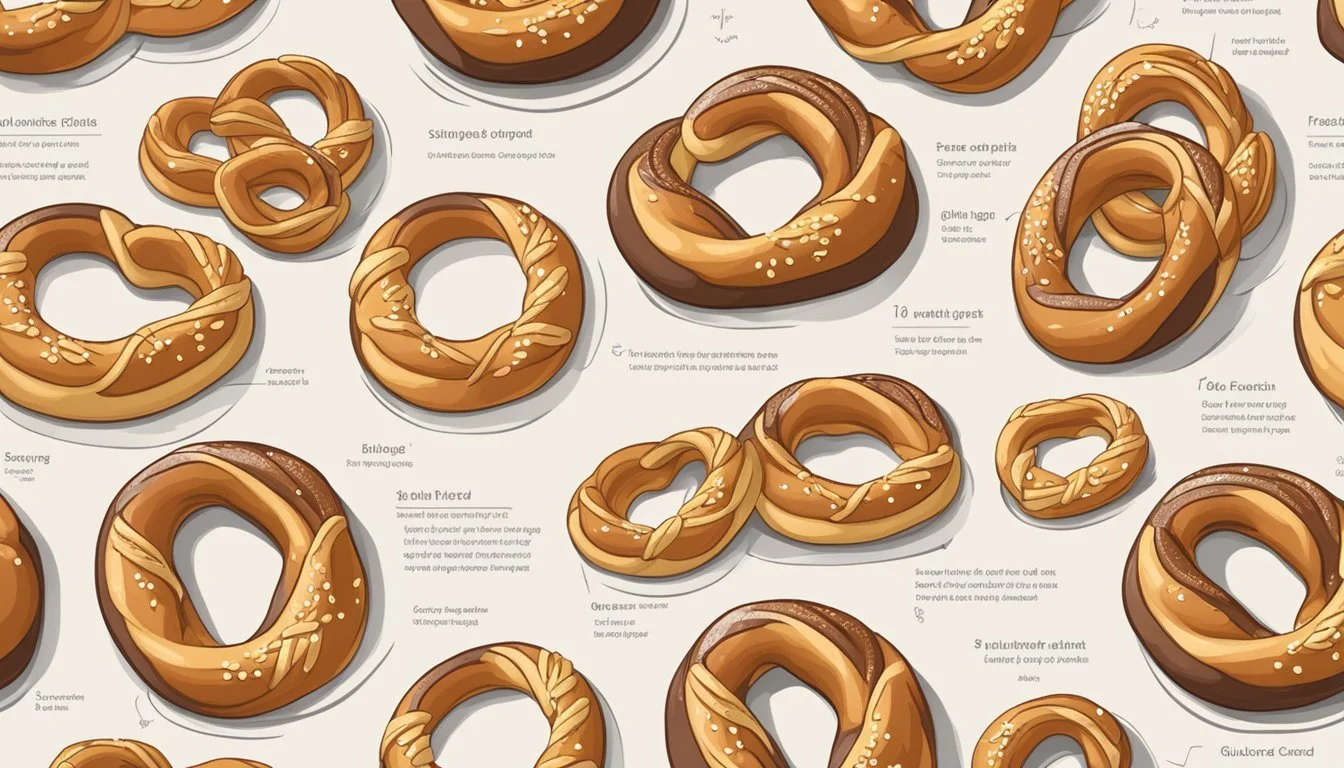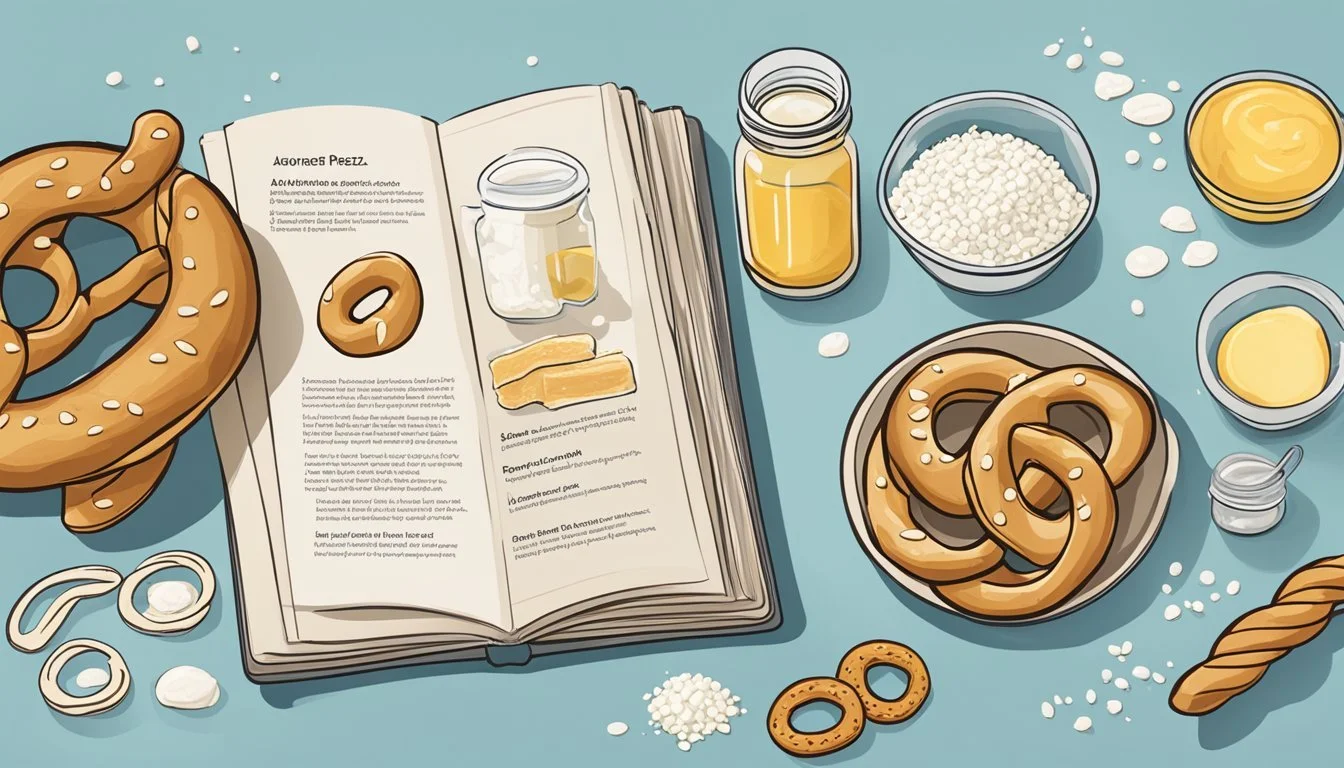Are Soft Pretzels Gluten-Free?
Understanding Their Ingredients and Alternatives
Soft pretzels are a beloved snack known for their chewy texture and distinctive twisted shape. Traditionally, they are made with wheat flour, which contains gluten, a group of proteins found in grains like wheat, barley, and rye. For those with celiac disease or gluten sensitivity, consuming gluten can lead to serious health issues, making it crucial for them to avoid traditional soft pretzels. However, with the rise in demand for gluten-free options, manufacturers and recipe creators have developed gluten-free soft pretzel alternatives.
Gluten-free soft pretzels are made using various alternative flours and binding agents to replicate the texture and flavor of their gluten-containing counterparts. Ingredients such as gluten-free flour blends, xanthan gum, and psyllium husk are often used to achieve a dough that can be shaped and baked into soft pretzels without the presence of gluten. These pretzels now come in various forms, including ready-made snacks in supermarkets and recipes for those who wish to bake them at home.
The availability of gluten-free soft pretzels has significantly increased, making it possible for those on a gluten-free diet to enjoy this classic snack without compromising their health. Specialized gluten-free brands have emerged, offering an array of pretzel products, including soft pretzels. Additionally, the increasing prevalence of gluten-free diets has prompted more local bakeries and food establishments to include gluten-free soft pretzels in their offerings.
What Are Soft Pretzels?
Soft pretzels are a popular baked good known for their distinct chewy texture and often larger size compared to their hard counterparts. They are traditionally topped with coarse salt and can be found in various shapes, with the most iconic being a twisted knot.
History and Origin
Soft pretzels boast a rich history, with their origin tracing back to early European monasteries. According to legend, monks created pretzels from leftover bread dough to reward children for their prayers, with the twisted shape representing arms crossed in prayer. This humble creation would eventually spread throughout Europe and make its way to North America, where it became a beloved snack.
Soft Pretzels vs. Hard Pretzels
The primary difference between soft and hard pretzels lies in their texture and moisture content. Soft pretzels, as the name implies, have a soft, chewy texture and are often enjoyed fresh and warm. They are typically larger in size and have a doughy interior. In contrast, hard pretzels are smaller, have a dry and crunchy texture, and are produced to have a longer shelf life. Both varieties can be seasoned with salt or other toppings, although soft pretzels are usually served with a more generous coating of coarse salt.
Understanding Gluten
When discussing soft pretzels and their relation to gluten, it's essential to understand what gluten is and how it affects those with gluten intolerances or sensitivities.
What Is Gluten?
Gluten is a family of proteins found in grains like wheat, barley, and rye. It's primarily composed of two main proteins: gliadin and glutenin, with gliadin being responsible for most gluten-related health effects. The presence of gluten in flour helps foods maintain their shape, acting as a glue that holds food together. Gluten is highly prevalent in many food products, especially baked goods like breads, pastries, and, notably, traditional pretzels.
Gluten Intolerance and Sensitivities
Individuals with gluten intolerance experience adverse reactions when consuming gluten. This includes those with celiac disease, a serious autoimmune disorder where gluten ingestion leads to damage in the small intestine. Symptoms of gluten intolerance can range from bloating and abdominal pain to more severe health problems if gluten is not excluded from the diet. A variety of gluten-free options exist for those affected, which use alternative flours and binding agents to replicate the qualities that gluten provides.
Gluten-Free Baking Essentials
In gluten-free baking, the right combination of flour blends and binders is critical to mimic the texture and structure traditionally provided by gluten. Knowing the suitable substitutes and alternatives allows for successful gluten-free recipes that don't compromise on taste or texture.
Gluten-Free Flours
The foundation of gluten-free baking is a good flour blend. These flours are made from grains, nuts, or starches that naturally contain no gluten.
Sorghum Flour: A whole grain flour that provides a tender crumb in baked goods.
Tapioca Starch: Often used in combination with other gluten-free flours to improve the texture and elasticity.
Rice Flour: A common base flour in many gluten-free mixes, available in both white and brown varieties.
A standard flour blend might combine these with others like potato starch or cornstarch to achieve the desired consistency in baking.
Binders for Gluten-Free Baking
Binders are critical in gluten-free baking for providing structure and elasticity.
Xanthan Gum: The most frequently used binder, xanthan gum can replace gluten's role in keeping baked goods from crumbling.
Psyllium Husk: Provides a fiber-rich alternative to xanthan gum, offering a whole-foods approach to binding ingredients.
The proportion of these binders varies per recipe, and too much can lead to an unpalatable, gummy texture, so precision is key.
Substitutions and Alternatives
Understanding substitutions is crucial for adapting conventional recipes to gluten-free standards.
Baking Powder: Gluten-free recipes often call for more leavening agents, like baking powder, to help the dough rise.
Ready-Made Flour Blends: These blends typically include xanthan gum or other binders and can provide a convenient substitution for regular flour in recipes.
It's important to note that direct substitutions may not always work, and adjustments for moisture or fat content might be necessary.
Making Gluten-Free Soft Pretzels
Crafting gluten-free soft pretzels requires selecting the right blend of ingredients and employing specific techniques to achieve that classic chewy texture without the presence of gluten. The process involves making the dough, shaping, and then boiling the pretzels before baking to perfection.
Choosing the Right Ingredients
To begin, one must choose gluten-free alternatives that mimic the properties of traditional wheat flour. The recipe demands a combination of gluten-free flour, xanthan gum, and a starch such as tapioca or arrowroot for structure and elasticity. Yeast is essential for leavening, while ingredients like buttermilk powder or yogurt can enhance the dough's texture. Brown sugar and salt are also added for flavor.
Flour Mixture Components:
Gluten-free flour
Xanthan gum
Tapioca, arrowroot, or cornstarch
Flavor and Texture Enhancers:
Brown sugar
Salt
Buttermilk powder or yogurt
Techniques and Tips for the Perfect Dough
When the baker begins the dough-making process, water should be warm, not hot, to activate the yeast without killing it. Using a stand mixer with a paddle attachment can ensure that all ingredients are thoroughly mixed without overworking the dough. It's important to allow the dough to rest and rise in a warm environment to help the yeast create a light structure.
Dough-Making Essentials:
Yeast: Warm water (not exceeding 110°F)
Mixer: Paddle attachment for even mixing
Rising: Warm place, free from drafts
Shaping and Boiling Process
Once the pretzel dough has doubled in size, it's time to divide it with a kitchen scale for uniformity, shape it into the traditional twist, and prepare for boiling. Boiling in a water solution with baking soda is crucial for developing a shiny crust. After boiling for a short time, the pretzels should be removed with a slotted spoon, drained, and then transferred to a baking sheet lined with parchment paper.
Steps for Shaping and Boiling:
Divide: Use a kitchen scale for even-sized dough pieces.
Shape: Roll into ropes and twist into a pretzel shape.
Boil: Water and baking soda solution for a shiny surface.
Before placing in a preheated oven, bakers often apply an egg wash for additional sheen or brush with melted butter for flavor. Baking at the right temperature until golden brown is the final step to achieving delicious gluten-free soft pretzels that rival their traditional counterparts.
Flavor Variations and Accompaniments
Soft pretzels offer a delightful versatility in flavor choices and pairings, easily customizable with various toppings and dips to suit any palate.
Classic Salted and Sweet Options
The classic salted soft pretzel, often sprinkled with coarse salt, remains a popular choice. This traditional version represents the savory side of soft pretzels and pairs exceptionally well with condiments like mustard or a warm cheese sauce. On the sweet end, cinnamon sugar-coated soft pretzels offer a delightful twist. The inviting aroma of butter and the subtle warmth of cinnamon sugar appeal to those with a sweet tooth, and these can be enjoyed with a light drizzle of honey for added sweetness.
Creative Toppings and Dips
Moving beyond the classic options, one may encounter soft pretzels encrusted with various seeds, nuts, or even parmesan. Creative toppings can include:
Sesame seeds
Poppy seeds
Crushed nuts
Shredded cheeses
For those craving a more decadent experience, soft pretzels can be dipped into an array of sauces. Some popular dip choices include:
Dip Type Main Ingredient Spicy Cheese Spiced Cheese blend Chocolate Melted Chocolate Caramel Rich Caramel sauce
Each dip brings its own distinct flavor profile to the pretzel, allowing for multiple taste experiences from a single, versatile base.
Storing and Reheating Instructions
Proper storage and reheating are crucial for maintaining the quality of soft pretzels. This ensures that the pretzels retain their intended texture and flavor when ready to enjoy again.
Keeping Soft Pretzels Fresh
To keep soft pretzels fresh, they should be stored in an airtight container at room temperature. They are best consumed within 1-2 days after baking. For longer storage, one might consider freezing them.
Best Practices for Freezing and Reheating
Soft pretzels can be frozen to extend their shelf life. To freeze soft pretzels:
Allow them to cool completely after baking.
Wrap each pretzel individually in plastic wrap.
Place the wrapped pretzels in a freezer-safe airtight container or a resealable freezer bag.
Label the container or bag with the current date.
Pretzels can be stored in the freezer for up to three months for optimal quality.
When ready to reheat, there is no need to thaw them; they can go directly from the freezer into the oven. To reheat frozen soft pretzels:
Preheat the oven to 350°F (175°C).
Unwrap the pretzels and place them on a baking sheet.
Heat for about 10-15 minutes or until fully warmed through.
For a quicker method, soft pretzels can be reheated in a microwave. However, this may affect their texture, making them softer and less crispy.
Advanced Gluten-Free Soft Pretzel Recipes
These recipes cater to those who seek a more sophisticated twist on the classic gluten-free soft pretzel, featuring gourmet touches and health-conscious ingredients suited for special occasions or dietary needs.
Gourmet Recipes for Special Occasions
For those special events where one wishes to impress, a gourmet gluten-free soft pretzel recipe can serve as an elegant addition. One might consider a gluten-free sourdough pretzel, which requires a gluten-free sourdough starter. The dough is often enriched with high-quality dairy-free butter and can be finished with coarse sea salt or even edible gold leaf for an opulent touch.
Another option for the connoisseur is to create pretzels with infused flavors. One may incorporate fresh herbs such as rosemary or thyme directly into the dough or opt for seeds like poppy or sesame to add texture and taste.
Healthy and Dietary Options
Health enthusiasts searching for a twist on gluten-free pretzels will appreciate recipes that blend both dietary mindfulness and flavor. Ingredients such as whole psyllium husk may be utilized to improve the fiber content while still achieving the desired chewy texture. When considering fats, selecting unsalted butter or a quality dairy-free alternative ensures the pretzels cater to lactose-intolerant individuals alongside gluten-sensitive ones.
A recipe may leverage a blend of gluten-free flours such as almond flour, buckwheat, or a certified gluten-free all-purpose mix for both health benefits and to provide a softer texture more reminiscent of traditional pretzels. Simple substitutions such as Greek yogurt or unsweetened applesauce can be used to reduce calories without compromising the dough's consistency or taste.
Navigating Gluten-Free Living
For individuals with gluten intolerance, identifying and purchasing suitable food options is crucial for maintaining health and well-being. Attention to product labeling and ingredient lists is the cornerstone of a safe gluten-free diet.
Shopping for Gluten-Free Products
When shopping for gluten-free products, individuals should look for certified gluten-free labels. The presence of such labels indicates that the product has met strict standards for gluten content. Online marketplaces often provide clearly marked gluten-free options, and many of these platforms offer affiliate links through newsletters, allowing consumers to purchase with ease. Additionally, health food stores and specialty sections in supermarkets typically carry a variety of gluten-free alternatives, including items such as frozen soft pretzels made without gluten.
Importance of Label Reading
Reading labels is an essential practice for anyone with gluten intolerance. They must diligently check not only for gluten-containing ingredients like wheat, barley, and rye but also for hidden sources such as malt flavoring or modified food starch. Cross-contamination is another concern, especially if the product is produced in a facility that also processes gluten-containing items. Thorough label reading helps individuals avoid accidental ingestion of gluten, thereby preventing potential health complications.
By prioritizing certified gluten-free products and meticulously examining product labels, individuals with gluten intolerance can safely enjoy a range of foods, including specialty items like soft pretzels, without compromising their health.
Closing Thoughts
When individuals consider soft pretzels, the traditional version made with wheat flour may initially come to mind, which contains gluten and is unsuitable for those with celiac disease or gluten sensitivities. However, the advent of gluten-free options has expanded the availability of this classic snack. The key to a gluten-free soft pretzel lies in the selection of alternative flours and binding agents to replace the gluten structure that wheat provides.
The gluten-free baking community often relies on blends of flours like tapioca starch, rice flour, or potato starch, and may incorporate xanthan gum or psyllium husk to mimic the chewy texture expected in a pretzel. Recipes may also suggest using specific commercially available gluten-free all-purpose flour blends as a convenient substitution.
For those purchasing ready-made products, it's crucial to look for pretzels that are explicitly labeled as "Gluten-Free." This ensures that the pretzels adhere to strict gluten-free standards, reducing the risk of cross-contamination with gluten-containing ingredients. Many brands have now embraced the production of gluten-free soft pretzels, making them more accessible than ever.
Notably, when making gluten-free soft pretzels at home, thorough mixing and correct ratios are essential to achieving the desired outcome. Enthusiasts should follow recipes with precision to enjoy a safe and satisfying pretzel experience.
In summary, gluten-free soft pretzels offer a delectable alternative for those avoiding gluten. With careful consideration of ingredients and preparation methods, one can enjoy this treasured snack without concern for gluten exposure.









